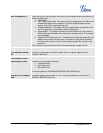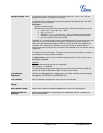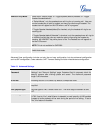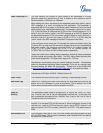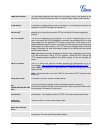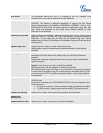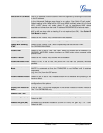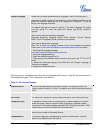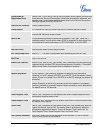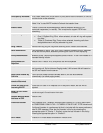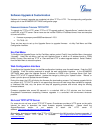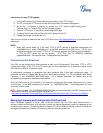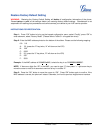
Grandstream Networks, Inc. GXP User Manual Page 38 of 44
Firmware 1.2.5.3 Last Updated: 03/2011
Authenticate Password
SIP service subscriber’s account password for GXP to register to (SIP) servers of
ITSP.
Name
SIP service subscriber’s name that is used for Caller ID display.
Use DNS SRV:
Default is No. If set to “Yes”, the client will use DNS SRV to look up server.
User ID is Phone
Number
If the phone has an assigned PSTN telephone number, this field should be set to
“Yes”. Otherwise, set it to “No”. If “Yes” is set, a “user=phone” parameter will be
attached to the “From” header in SIP request
SIP Registration
This parameter controls sending REGISTER messages to the proxy server. The
default setting is “Yes”.
Un-register on Reboot
Default is “No”. If set to “Yes”, the SIP user’s registration information will be
cleared from the server when the phone reboots.
SIP Instance ID
Default is set “No.” If set to Yes it will be enabled and will add reg-ID and Instance
ID on contact header in the REGISTER messages. This feature is mainly
provided for servers that don't support SIP Instance ID feature, but will still allow
phones to register.
Register Expiration
This parameter allows user to specify the time frequency (in minutes) that GXP
refreshes its registration with the specified registrar. The default interval is 60
minutes. The maximum interval is 65,535 minutes (about 45 days).
Local SIP Port
This parameter defines the local SIP port used to listen and transmit. The default
value for Account 1 is 5060. It is 5062, 5064, 5066 for Account 2, Account 3 and
Account 4 respectively.
SIP Registration Failure
Retry Wait Time
Retry registration if the process failed. Default is 20 seconds.
SIP T1 Timeout
RFC 3261 SIP T1 timer. Default is 1 second.
SIP T2 Interval
RFC 3261 SIP T2 timer. Default is 0.5 seconds.
SIP Transport
Choose SIP Transport between UDP and TCP. Default is UDP.
Use RFC3581
Symmetric Routing
Default No. When selected the phone will follow the routing procedures specified
in RFC3581.
NAT Traversal (STUN)
This parameter activates the NAT traversal mechanism. If activated (by choosing
“Yes”) and a STUN server is also specified, the phone performs according to the
STUN client specification. Using this mode, the embedded STUN client detects if
and what type of NAT/Firewall configuration is used. If the detected NAT is a Full
Cone, Restricted Cone, or a Port-Restricted Cone, the phone will use its mapped
public IP address and port in all of its SIP and SDP messages. If the NAT
Traversal field is set to “Yes” with no specified STUN server, the GXP will
periodically (every 20 seconds or so) send a blank UDP packet (with no payload
data) to the SIP server to keep the “hole” on the NAT open.
SUBSCRIBE for MWI:
Default is No. When set to “Yes” a SUBSCRIBE for Message Waiting Indication
will be sent periodically.



